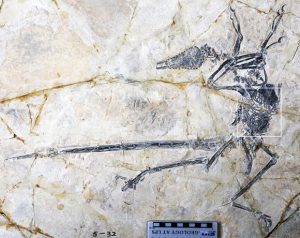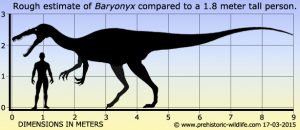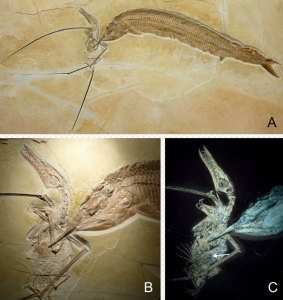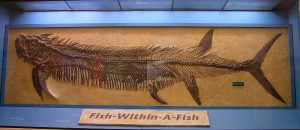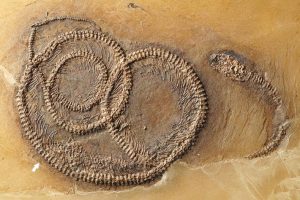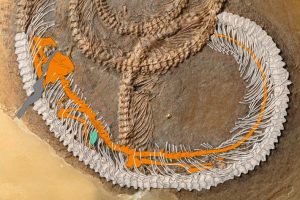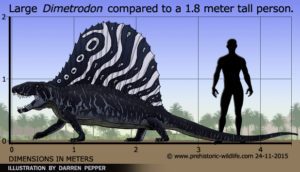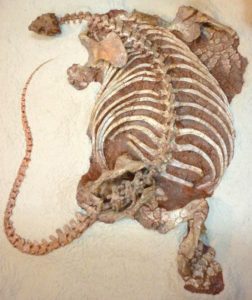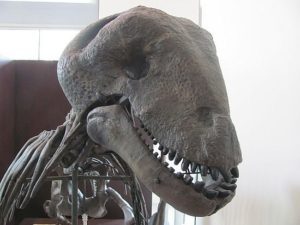Podcast: Play in new window | Download (Duration: 9:49 — 10.9MB)
Thanks to Clay for suggesting this week’s topic, psittacosaurus! Thanks to Will for a correction about kangaroos too.
Don’t forget to check out the great podcast I Know Dino for all the best big dinosaur info!
Further reading:
What dinosaurs’ colour patterns say about their habitat
Unusual fossil shows rare evidence of a mammal attacking a dinosaur
A countershaded psittacosaurus model [photo by Jakob Vinther, from first article linked above]:
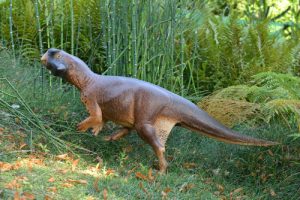
Repenomamus and psittacosaurus, fighting forever [photo from second article linked above]:
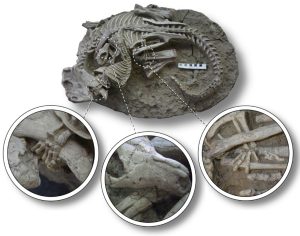
Show transcript:
Welcome to Strange Animals Podcast. I’m your host, Kate Shaw.
This week we’re going to look at a dinosaur suggested by Clay, who has been very patient waiting for this one. In a huge coincidence, the podcast I Know Dino is trading promos with us, so if you haven’t heard about I Know Dino yet, make sure to listen until the very end of this episode for some more information about it. It’s a great podcast that I love to pieces, and I think you’ll love it too.
We also have a quick correction, and I feel really bad because this one should have gone in the updates episode last month. Will emailed me back in April to point out that in episode 73, about phantom kangaroos, I said that kangaroos and wallabies were native to Australia, New Zealand, and New Guinea. In fact, they’re not native to New Zealand, although they’ve been introduced there. So yikes, that was a big oversight on my part, and thanks very much to Will!
Now, on to Clay’s suggestion, psittacosaurus!
Psittacosaurus was a type of ceratopsian that lived during the early Cretaceous, between about 125 and 100 million years ago. We’ve talked about ceratopsians before back in episode 125, so if you remember that episode you’ll know that ceratopsians were big herbivorous dinosaurs famous for their head frills and horns. Triceratops is the most famous example, although it had lots of relations. But Psittacosaurus was a very early ceratopsian, and it’s nothing like Triceratops.
If you had a time machine and went back to look at Psittacosaurus, you might not even think it was related to Triceratops at all. It didn’t have real horns or frills, most species were only about six and a half feet long at most, or two meters, but most importantly, it walked on its hind legs.
We have hundreds of Psittacosaurus fossils, so we know quite a bit about it. Young individuals apparently walked on all four legs, but as it grew up, Psittacosaurus became bipedal. It still ate plants, though, and may have specialized in eating seeds and other tough plant materials. It couldn’t chew its food the way later ceratopsians could, but it did swallow little stones to help it grind up hard plant parts. These gastroliths have been found preserved with Psittacosaurus fossils.
Psittacosaurus lived in what is now Asia, especially eastern and central Asia, and probably spent most of its time in forested areas. Because it lived only in the early Cretaceous, and because it was such a common animal with so many fossils found, if a paleontologist finds a Psittacosaurus fossil at a dig site, they can be pretty confident that the site dates to the early Cretaceous. Paleontologists have identified about twelve species of Psittacosaurus so far, although there’s still debate about the actual number of species, and at least some of them had feathers. We know because we have some well-preserved fossils with feather and skin impressions.
Psittacosaurus wasn’t completely covered with feathers, though. Its feathers were bristle-like and have only been found sticking up along the top of the tail. Scientists think they were probably used for display. That means they were probably brightly colored, so if you go back in that time machine I mentioned earlier, please make sure to take lots of pictures.
In fact, Clay said that Psittacosaurus looks like it’s “half parrot, half porcupine and half dinosaur” (that is actually one and a half animals, Clay, but we know what you mean and that actually is a really good description of it). Psittacosaurus’s bristles stuck up kind of like porcupine quills, although they weren’t sharp. Careful study of the quills shows that they were probably more like highly modified scales instead of feathers like you’d find on a modern bird, and that they grew around 6 inches long, or 15 cm. Some modern birds do actually have bristles like this, including the turkey. Most male turkeys, and some females, have a bundle of hair-like bristles on the breast that’s called a beard.
Psittacosaurus’s name means “parrot lizard” because of the shape of its beak, which may have helped it crack seeds and nuts. Its head kind of resembled that of a turtle, although unlike a turtle it also had teeth. Its head was broad with cheekbones that jutted out sideways, sometimes so far that it looked like it had horns on the sides of its face just above the jaw. At least one species had prominances behind the eye that again, kind of look like little horns but technically aren’t.
We even have a hint about what Psittacosaurus looked like. A study published in 2016 examined preserved melanosomes, which are the structures that pigment an animal’s skin and feathers. The study determined that Psittacosaurus had a light-colored belly and was darker on its back. This is called countershading and it’s very common because it acts as a form of camouflage.
As part of the study, scientists created two life-sized models of Psittacosaurus. One of them they painted gray all over, while the other they painted brown with lighter brown underparts. They took the models to the Bristol Botanic Garden in the UK, which has a section with plants from the Cretaceous. (This sounds awesome and I really want to visit.) They placed the models in various spots and photographed them, then compared how well the models were camouflaged. The countershaded model was most well camouflaged in forested areas, which matches up with what scientists know about how it lived.
In addition to the fossils with skin and feather impressions, we have lots of fossils of Psittacosaurus of all ages, from newly hatched to big old dinosaurs. We even have a fossilized juvenile Psittacosaurus preserved in what would have been the stomach of Repenomamus, and it looks like the little dinosaur was bitten into pieces before being swallowed. Repenomamus was a mammal that was built like a miniature badger.
For a long time scientists weren’t sure if Repenomamus hunted baby dinosaurs or just scavenged ones that were already dead. Then, in 2012, an amazing fossil was unearthed in China. A study of the prepared fossil was just released in July 2023.
The fossil is of two animals, Repenomamus and Psittacosaurus. The Psittacosaurus was bigger than the Repenomamus but not by much. The two animals died suddenly when they were buried in a mudslide following a volcanic eruption, and their skeletons are tangled up together. But this wasn’t just chance. A close look reveals details that show they’d been fighting ferociously even while the mudslide was bearing down on them. Repenomamus has one little front foot wrapped around the jaw of Psittacosaurus, a back foot wrapped around one of the dinosaur’s hind legs, and its jaws are biting at Psittacosaurus’s ribs. It looks like the mammal was winning the fight, but in this particular case no one got out alive.
You can find Strange Animals Podcast at strangeanimalspodcast.blubrry.net. That’s blueberry without any E’s. If you have questions, comments, or suggestions for future episodes, email us at strangeanimalspodcast@gmail.com. We also have a Patreon at patreon.com/strangeanimalspodcast if you’d like to support us for as little as one dollar a month and get monthly bonus episodes.
Thanks for listening!
Rediscover your love for dinosaurs with I Know Dino, the Big Dinosaur Podcast!
A new dinosaur is discovered and named nearly every week and I Know Dino covers the latest scientific discoveries, fun facts about dinosaurs, and a deep dive into a specific dinosaur.
I Know Dino is made by adults for adults, but we keep it clean so kids who are science buffs can listen too. You can find it wherever you get your podcasts.
